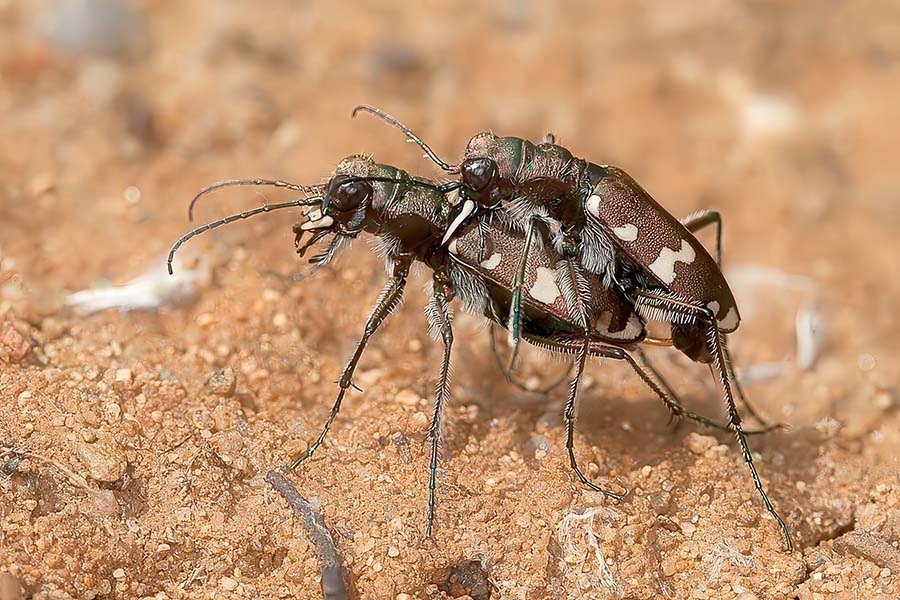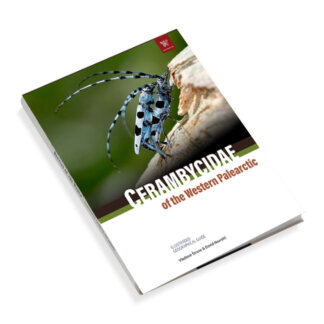Book novelties:
Prioninae of the World I., Cerambycidae of the Western Paleartic I. June Bugs,
Types of beetles insects
New E-Book: Ground Beetles, Tiger Beetles, Longhorn Beetles, Jewel Beetles, Stag Beetles, Carpet Beetles, Scarab Beetles, Rhinoceros Beetles, Weevil Beetles, Blister Beetles, Leaf Beetles, Flower Beetles,
Start Shopping, Start Saving – prices from $3 USD
We recommend:
jeweled beetles, ground beetles, longhorn beetles, goliath beetle, stag beetle, carpet beetles
Tiger Beetle
Cicindelidae
Tiger beetles (family Cicindelidae) are fascinating insects known for their vibrant colors, incredible speed, and predatory skills. Found in various habitats worldwide, especially in tropical and subtropical regions, these beetles play important roles in ecosystems and have attracted the attention of scientists studying predator-prey interactions and insect adaptations.
Unique pictorial atlases for identifying Beetles:
(2020) Tiger Beetles of the World, Cicindelidae, Illustrated guide to the genera
(2023) Tiger Beetles of Africa, Cicindelidae, Geographical guide to the family Cicindelidae
(2024) Tiger Beetles of Orient, Cicindelidae, Geographical guide to the family Cicindelidae
(2022) Ground Beetles of Africa, Afrotropical Region
(2022) Jewel Beetles of the World, Buprestidae, Illustrated guide to the Superfamily Buprestoidea
(2008) The Prionids of the World, Prioninae, Illustrated catalogue of the Beetles
(2010) The Prionids of the Neotropical region, Prioninae, Illustrated catalogue of the Beetles
Classification and Diversity
Tiger beetles belong to the order Coleoptera (beetles) and have traditionally been classified as their own family, Cicindelidae. However, modern research places them as a subfamily, Cicindelinae, within the larger family Carabidae (ground beetles). There are over 2,600 species of tiger beetles grouped into different genera and tribes.
Recent taxonomic studies continue to refine our understanding of tiger beetle diversity. For example, researchers have created new genera to better classify species with unique features. In Pakistan alone, 55 species from 14 genera have been documented, including some newly recorded species like Cicindela viridilabris and Neocollyris redtenbacheri. These discoveries highlight the wide distribution of tiger beetles across the globe.
Physical Features
Tiger beetles are easily recognizable due to their slender bodies (10–20 mm long), long legs, and large eyes that provide excellent vision—an essential trait for hunting prey. Their metallic colors range from iridescent blue and green to bright orange or scarlet. These colors are produced by pigments and structural properties in their exoskeletons, which also help some species blend into their environments for camouflage.
Their sharp mandibles (jaws) are another key feature, allowing them to capture and dismember prey effectively. For example, the six-spotted tiger beetle (Cicindela sexguttata) has shiny green coloration with six white spots on its wing covers (elytra), making it a striking example of this group.
Bug Posters, Insect Posters

Hunting Strategies
Tiger beetles are aggressive hunters with different strategies depending on their life stage:
-
Adult Hunting: Adults are among the fastest insects on Earth. Some species can run at speeds of 2.5 meters per second! They use their speed and sharp vision to chase down prey in open areas like sandy beaches or forest paths.
-
Larval Hunting: Larvae live in burrows they dig in soil or sand. They wait at the entrance of their burrow for prey to pass by and then strike quickly with their sickle-shaped jaws. Hooks on their abdomen anchor them in place during struggles with larger prey.
Habitat and Distribution
Tiger beetles live in diverse environments worldwide, from sandy beaches to forest clearings. Most prefer sunny areas where their excellent eyesight works best. Some species have adapted to unique habitats:
-
Termite Nests: Certain tropical species live alongside termites.
-
Tree-Dwelling: Others hunt on tree trunks instead of the ground.
-
Semi-Aquatic: Some species live near water and even hunt on its surface.
Their ability to adapt to specific habitats explains why they are found across different biogeographical regions.
Life Cycle
Tiger beetles go through complete metamorphosis: egg → larva → pupa → adult. Females lay eggs in soil, where larvae construct burrows for hunting and protection. The larval stage lasts 1–3 years before pupating underground. Adults emerge from these burrows during warm seasons to hunt and reproduce.
Ecological Importance
Tiger beetles play key roles in ecosystems by controlling populations of smaller insects through predation. Their sensitivity to environmental changes also makes them useful indicators of ecosystem health. However, habitat loss and climate change threaten some species due to their specialized living requirements.
Conclusion
Tiger beetles are remarkable insects that combine beauty with ecological importance. Their speed, hunting strategies, and adaptability make them successful predators across diverse habitats. As scientists continue to study these beetles’ evolutionary history and ecological roles, they remain valuable subjects for conservation efforts and environmental research.
This version simplifies complex terminology while retaining important information about tiger beetles for student readers!
Cicindelidae, Tiger Beetle
One of the most notable characteristics of Tiger Beetles is their exceptional running ability. Some species can reach speeds of up to 9 km/h (5.6 mph), making them one of the fastest insects relative to body size. This speed is facilitated by their long legs and streamlined bodies, which allow them to navigate swiftly through their habitats while hunting for prey.
Tiger Beetles are primarily carnivorous, feeding on a diet that consists mainly of other insects. Their predatory behavior is characterized by a unique hunting strategy; they often chase down their prey rather than ambushing it. This active hunting style is supported by their acute vision, which enables them to detect movement from a considerable distance. Studies have shown that their compound eyes provide a nearly 360-degree field of vision, enhancing their ability to spot potential food sources.
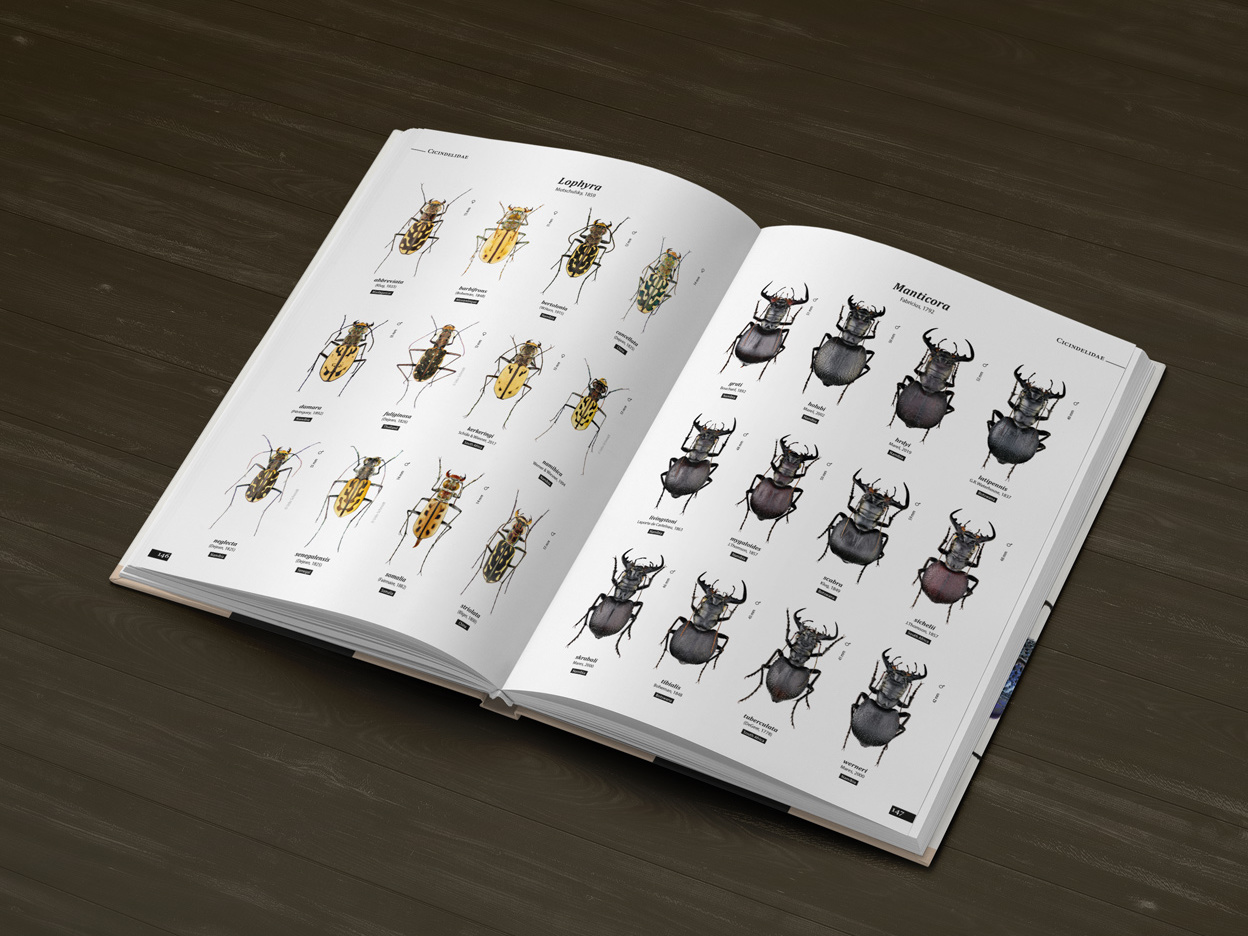
In terms of morphology, Tiger Beetles exhibit a wide range of colors and patterns, which can serve various purposes, including camouflage and warning signals to potential predators. The coloration is often iridescent, reflecting light in a way that can be visually striking. This diversity in appearance is not only fascinating but also plays a crucial role in their survival strategies.
Reproductive behaviors in Tiger Beetles are equally intriguing. Females typically lay their eggs in sandy or loose soil, where the larvae can burrow and develop. The larval stage is predatory as well, with larvae exhibiting a unique behavior of ambushing prey that comes too close to their burrows. This dual predatory lifestyle, both as adults and larvae, contributes to their ecological role as effective pest controllers.
Conservation status varies among Tiger Beetle species, with some facing threats due to habitat loss and environmental changes. Conservation efforts are essential to ensure the survival of these insects, as they play a vital role in maintaining ecological balance by controlling pest populations.
In summary, the Tiger Beetle is a remarkable example of adaptation and specialization in the insect world. Their speed, predatory behavior, and diverse morphology make them a subject of interest for entomologists and nature enthusiasts alike. Understanding the biology and ecology of Tiger Beetles can provide valuable insights into the health of ecosystems and the importance of biodiversity.
Tiger Beetles are distinguished by their remarkable speed, with certain species achieving velocities of up to 9 km/h (5.6 mph), making them among the fastest insects relative to their body size. Their elongated legs and aerodynamic bodies enable rapid movement through their environments while pursuing prey.
These insects are primarily carnivorous, consuming a diet rich in other insects. Their hunting strategy involves actively chasing prey rather than relying on ambush tactics, supported by exceptional vision that detects movement over long distances. Research indicates their compound eyes provide nearly 360-degree visibility, enhancing their ability to locate food sources.
Morphological Diversity
Tiger Beetles display striking color variations and patterns, often serving as camouflage or warning signals to predators. Their iridescent hues reflect light in visually striking ways, contributing to survival strategies while captivating observers.
Reproductive and Larval Behavior
Females deposit eggs in sandy or loose soil, where larvae develop and employ ambush tactics to capture prey near their burrows. This dual predatory lifestyle—active hunting as adults and ambush predation as larvae—positions them as effective ecological pest controllers.
Conservation Challenges
While some species thrive, others face threats from habitat destruction and environmental shifts. Preserving these insects is critical, as they maintain ecological balance through pest regulation.
Conclusion Tiger Beetles
Tiger Beetles exemplify evolutionary specialization, blending speed, predatory prowess, and adaptive coloration. Studying their biology offers insights into ecosystem health and biodiversity’s importance, making them a compelling subject for entomologists and nature enthusiasts.
This version maintains factual accuracy while using alternative phrasing and structure to emphasize key traits and ecological roles.
We recommend: jeweled beetles, ground beetles, longhorn beetles, goliath beetle, stag beetle, carpet beetles
Books about Beetles
Family Cicindelidae Latreille, 1802
Tribe Cicindelini Latreille, 1802
-
Subtribe Apteroessina Rivalier, 1971
-
Subtribe Cicindelina Latreille, 1802
-
Subtribe Dromicina J. Thomson, 1859
-
Subtribe Iresiina Rivalier, 1971 P
-
Subtribe Theratina W. Horn, 1893
Tribe Collyridini Brullé, 1834
-
Subtribe Collyridina Brullé, 1834
-
Subtribe Tricondylina Naviaux, 1991
Tribe Ctenostomatini Laporte, 1834
Tribe Manticorini Laporte, 1834
Tribe Megacephalini Laporte, 1834
Tribe Oxycheilini J. Thomson, 1857

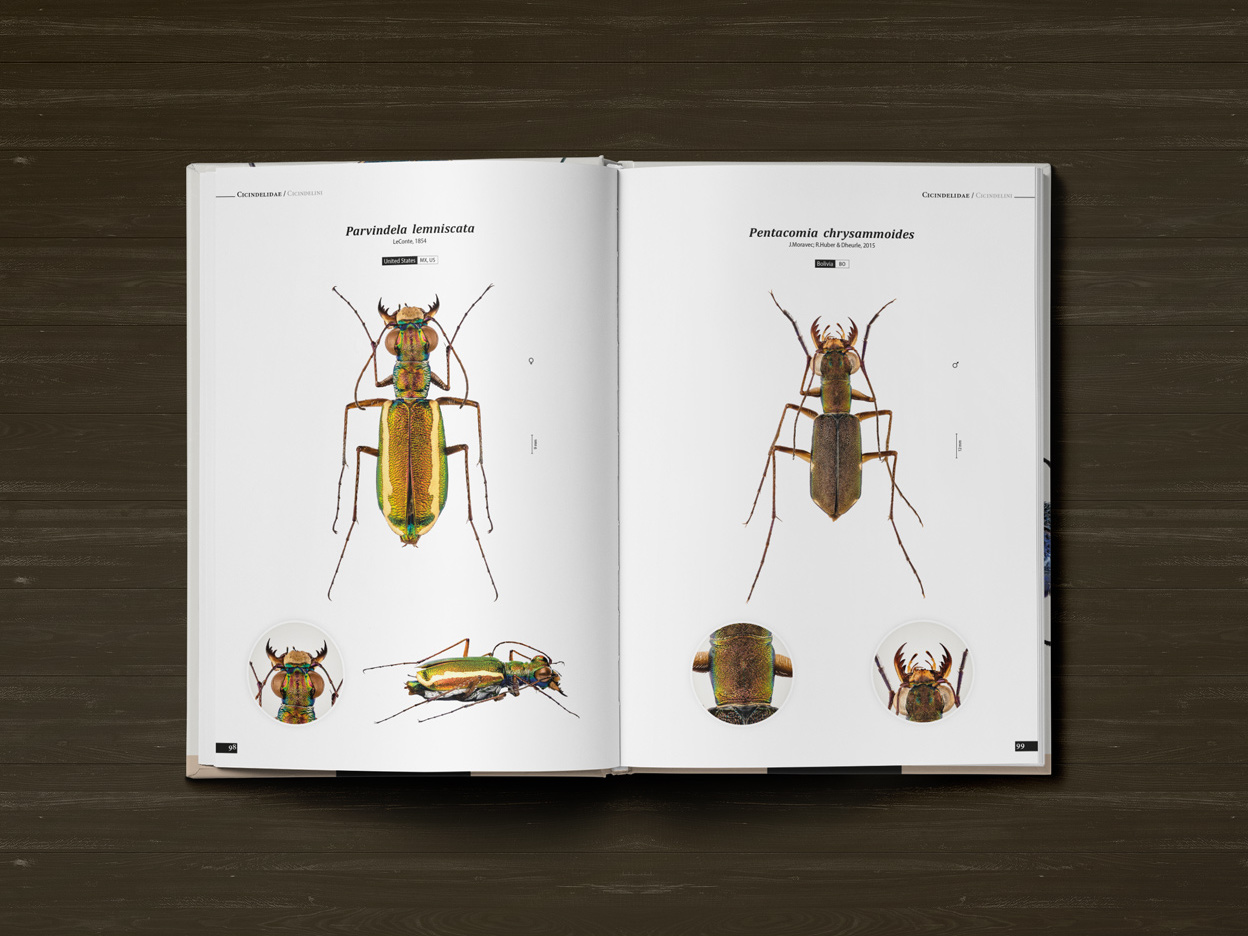
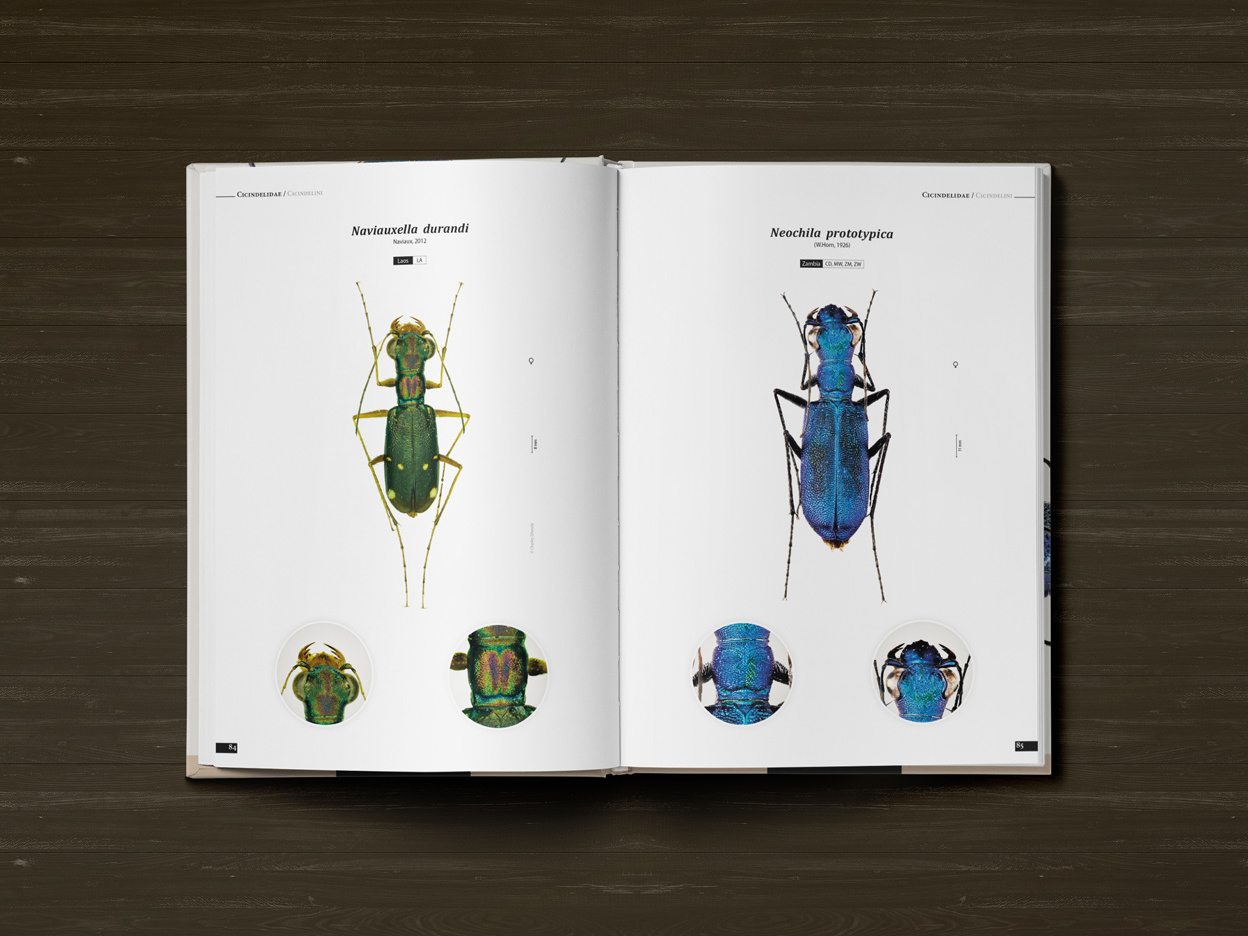


Family Cicindelidae: Advantages and Disadvantages
Introduction
The family Cicindelidae, commonly known as tiger beetles, comprises over 2,600 species of beetles renowned for their predatory habits and impressive speed. These beetles are found worldwide, often inhabiting sunny, sandy areas near bodies of water. This article will explore the advantages and disadvantages associated with the family Cicindelidae.
Advantages
Ecological Role:
Predation: Tiger beetles are voracious predators, feeding on a variety of insects and spiders. This helps maintain ecological balance by controlling pest populations, which can be beneficial for agriculture and natural ecosystems.
Biodiversity Indicators: Due to their sensitivity to environmental changes, tiger beetles serve as excellent indicators of biodiversity and ecosystem health.
Speed and Agility:
Tiger beetles are among the fastest insects on Earth, with some species reaching speeds of up to 2.5 meters per second. This speed allows them to efficiently hunt and evade predators.
Their agility and rapid movement make them fascinating subjects for scientific study, particularly in the fields of biomechanics and sensory perception.
Diverse Habitats:
Tiger beetles inhabit a wide range of environments, from sandy beaches to woodland paths, contributing to their ecological diversity and adaptability.
Disadvantages
Predation Pressure:
While tiger beetles help control pest populations, they can also exert significant predation pressure on beneficial insects. This might disrupt local food chains if their populations become too dominant.
Potential for Overexploitation:
The larvae of tiger beetles are often targeted by parasitic wasps, which can lead to overexploitation of certain tiger beetle species. This could impact their populations and ecological roles.
Limited Defensive Mechanisms:
Despite their speed, tiger beetles have limited defensive mechanisms against larger predators. Their reliance on speed and agility makes them vulnerable in certain situations.
Environmental Sensitivity:
Tiger beetles are sensitive to environmental changes, which can make them vulnerable to habitat destruction and climate change. This sensitivity, while useful for monitoring ecosystems, also poses a threat to their survival.
Tiger beetles
The family Cicindelidaem, Tiger beetles offers numerous ecological benefits, including pest control and biodiversity monitoring. However, their predation activities and environmental sensitivity also present challenges. Understanding these aspects is crucial for managing ecosystems effectively and ensuring the long-term survival of these fascinating insects.
Speed and Predators of Tiger Beetles
Tiger beetles are famous for their astonishing speed, with the Australian tiger beetle holding the title of the fastest-running insect. If scaled to human size, its velocity would surpass that of a cheetah. Despite their swiftness, these beetles are not without threats—birds and ants frequently prey on their larvae.
Habitat and Diet
Preferring sandy environments, tiger beetles serve as key bioindicators of ecological health. Their diet mainly consists of small insects and spiders, which they skillfully hunt using both their rapid movements and strong mandibles. Although they are fierce predators in their world, they pose no danger to humans.
Life Cycle and Diversity
The life cycle of tiger beetles includes a larval stage, during which they reside in burrows and ambush passing arthropods. As summer arrives, adult beetles emerge, displaying striking colors and impressive agility. With over 2,600 species documented worldwide, each one exhibits distinct traits.
Running Speed Compared to Humans
Some tiger beetle species are capable of running at such extraordinary speeds that, if adjusted for human proportions, they would reach over 700 mph. While they are harmless to people, their agility allows them to capture prey with remarkable efficiency, playing a crucial role in maintaining ecological balance.
Safety and Global Distribution
Tiger beetles are non-toxic and pose no threat to humans. Found across various regions, including the UK, they thrive in open, sandy areas. Their survival is closely linked to water availability, which significantly influences their preferred habitats.
Scientific Classification and Notable Species
Tiger beetles, classified within the family Cicindelidae, are among the fastest terrestrial insects. Capable of reaching speeds up to 5.6 miles per hour, they are faster than many other insect species and exhibit speeds comparable to those of small mammals. This exceptional running ability enables them to efficiently capture prey, making them highly effective predators. The Cicindelidae family includes a diverse array of species, such as the manticora tiger beetle and the six-spotted tiger beetle, each exhibiting distinct characteristics.
As carnivores, tiger beetles primarily feed on other insects, which they catch using their remarkable speed. Their diet typically includes ants, flies, and other small invertebrates. Equipped with powerful mandibles, tiger beetles are able to subdue and consume their prey with efficiency. Certain species, such as the green tiger beetles, are known to inhabit sandy or forested environments, where prey is plentiful. These beetles are often found in various habitats, including beaches, woodlands, and even along roadsides.
The scientific nomenclature of tiger beetles varies depending on the species. For example, the water tiger beetle and the six-spotted tiger beetle each have their own specific scientific names. The Cicindelidae family is comprised of numerous species, each exhibiting unique traits such as size, coloration, and habitat preferences. Species found in the United Kingdom, for instance, may differ significantly from those in Australia or other regions. The Australian tiger beetle is particularly noted for its speed and agility, often moving so rapidly that its movements appear blurred.
Many tiger beetle species, including the Manticore tiger beetle, are available in the insect trade. These beetles can be purchased from online retailers or specialty insect shops. Due to their dynamic behavior, particularly their running patterns and predatory habits, they can be intriguing pets. However, it is important to recognize that tiger beetles are predators, requiring an environment that suits their biological needs for optimal well-being.
Despite their impressive hunting abilities, tiger beetles do not pose significant danger to humans. Although they possess venom, it is not harmful to humans, and their bites, while painful, are generally not dangerous unless provoked. Many species, including the six-spotted tiger beetle, are non-venomous and can be handled safely in most situations. Their rapid and unpredictable movements, however, may startle observers. Their remarkable speed, which can be compared to that of a cheetah in relation to their size, plays a crucial role in evading predators, contributing to their survival.
Tiger beetles are commonly associated with habitats that feature sandy or loose soil, where they can burrow and remain concealed between hunts. They thrive in areas with ample space for running and hunting. Whether found in the coastal regions of Australia, the woodlands of the UK, or arid habitats, the diversity of their environments reflects the adaptability of the various tiger beetle species.
In conclusion, tiger beetles are fascinating organisms, distinguished by their remarkable speed and predatory nature. The vast diversity within the Cicindelidae family, from green to six-spotted tiger beetles, demonstrates the evolutionary adaptations that allow these beetles to thrive in a wide range of ecosystems across the globe. Whether one is interested in studying their speed, learning about their ecological roles, or considering them as pets, tiger beetles present numerous opportunities for exploration and learning.
-
 Types of beetles insects€ 13.00
Types of beetles insects€ 13.00 -
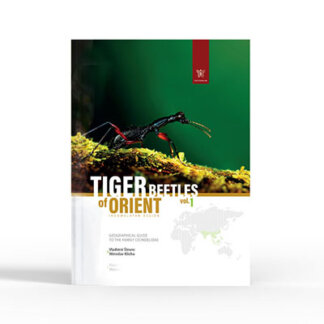 Tiger Beetles of Orient€ 129.00
Tiger Beetles of Orient€ 129.00 -
 Tiger Beetles of Africa€ 129.00
Tiger Beetles of Africa€ 129.00 -
 The Prionids of the WorldProduct on sale€ 59.00
The Prionids of the WorldProduct on sale€ 59.00 -
 Ground Beetles of Africa (2nd edition)€ 136.00
Ground Beetles of Africa (2nd edition)€ 136.00 -
 Jewel Beetles of the World€ 105.00
Jewel Beetles of the World€ 105.00 -
 Tiger Beetles of the World€ 109.00
Tiger Beetles of the World€ 109.00 -
 The Prionids of the Neotropical regionProduct on sale€ 59.00
The Prionids of the Neotropical regionProduct on sale€ 59.00
